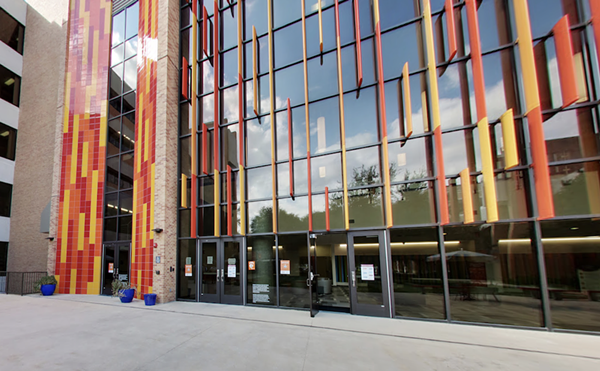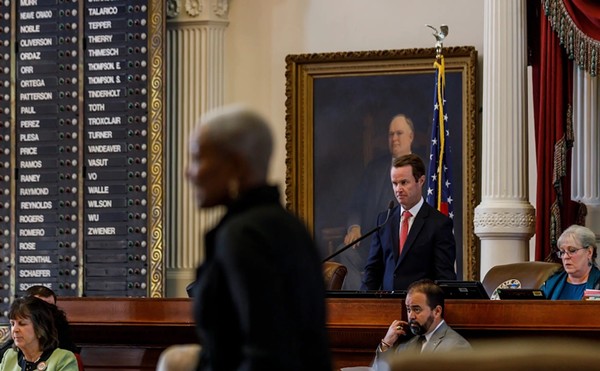More kennels for No Kill
This week, the City concluded a round of public meetings designed to canvas citizens about spay/neuter options, pet licensing, tethering, and animal sales before revisions to the Chapter 5 ordinance covering animal issues are proposed to Council in mid-May. We attended the District 2 meeting last week, and found Animal Care Services Director Gary Hendel’s honesty refreshing, and disturbing. As with most other departments, the City slashed Animal Care Services’ budget last year, removing $750,000 and 14 positions. The bulk of the lost funding would have gone to the City’s spay and neuter budget, a crucial component of the No Kill roadmap. Currently, Hendel says, the City of Dallas, population 1.2 million, has 60 officers in the field. San Antonio, population 1.3 million, has 28.
Think on that next time your stray-animal calls go unanswered. To help manage the 88,000 calls for service in the past year alone, Hendel said 311 and ACS developed a ranking system. A Priority 1 call means an animal is currently attacking. Priority 2 is an animal chasing a human or acting in a seriously aggressive manner. Priority 5 (3 and 4 don’t exist, yet) are calls about any other sort of stray animal. If your call is Priority 5, “we don’t care,” Hendel said bluntly. “I care. My officers care. But we don’t have time.”
Hendel, who came to San Antonio from Portland’s Animal Control Division 10 months ago, says that another reason so many strays don’t meet the dog/cat catcher in a timely manner is the swanky $12 million Animal Care Services campus the City opened in 2007, which, despite covering 38,000 square feet, managed to reduce the number of kennels from 334 to 193. “We’ve handcuffed `our officers`,” Handel said. “We’ve said, ‘Stop doing what you’re good at, we don’t have space.’”
Absent a boatload of cash, a few regulatory items are under consideration:
1) Spay/neuter. San Antonians seem to like
their pets intact, meaning balls swinging and bitches in heat. Animal Care Services still hasn’t figured out the best way to strongly encourage pet owners to spay and neuter their animals, but up for discussion is a mandatory spay/neuter policy, excluding police dogs, purebred breeders, and show animals.
2) Tethering. It might seem like an easy option
for owners without a fence in their yard, but not only can tethering dogs outside expose them to harsh elements, it can leave unspayed females open to gang bangs by unneutered male dogs. Hendel says these females act as bait luring packs of the City’s most aggressive animals right to the tetherer’s doorstep.
3) Puppy sales. QueQue’s favorite pun of the
evening was “impounding puppies.” Hendel proposes confiscating illegal puppy litters for sale and imposing steep fines on unlicensed breeders.
4) Female pets in heat. Keep them inside.
’Nuff said.
It’s no secret that San Antonio won’t make its No Kill 2012 goal. “There’s no way on God’s green earth,” said Hendel. Not with the current budget and department size. “I believe San Antonio could be No Kill in 10 years.”
The City’s definition of No Kill is that 70 percent of healthy, adoptable animals that come into the shelter are adopted out. Right now, Hendel says San Antonio is at 35 percent, a commendable increase from 12.5 percent four years ago, but nowhere near the final goal.
Immediate help may be on the way for ACS’s over-booked kennels. A proposal described to us just Monday as “pie in the sky” by Animal Care Services has made its way onto this week’s City Council agenda: the takeover of abandoned kennel space at Brooks City Base for an auxiliary shelter that could hold an estimated 10,000-12,000 animals annually, or about 50 percent of the 23,000 ACS took in during FY 2009. The ordinance on Thursday’s agenda would authorize transferring funding from the FY 2010 General Fund to cover nine additional staff positions for the new kennel and $125,000 to renovate the existing space. Much of the funding would come from $500,000 previously authorized to add 50 additional kennels to ACS’ main campus, which would be canceled in favor of the Brooks City Base site. Additional cash would come from savings in the General Fund. During the D2 meeting that QueQue attended, Hendel said that if the ordinance passes, he expects the new kennels to be operational by July 1, 2010.
Hire-back at the Hyatt
Employees at the Grand Hyatt San Antonio will soon find a new notice posted on back-room walls of the downtown hotel, thanks to a settlement between the hotel, the U.S. National Labor Relations Board, and ambitious service-industry union Unite Here.
To give you a taste of the substance of the two-page flyer, it opens:
FEDERAL LAW GIVES YOU THE RIGHT TO
•Form, join or assist a union;
•Choose representatives to bargain
with us on your behalf,
•Act together with other employees
for your benefit and protection;
•Choose not to engage in any of
these protected activities.
WE WILL NOT do anything to interfere with those rights.
That last line may represent a change in behavior for the company, which current and former employees in San Antonio and elsewhere accuse of using intimidation tactics to prevent staff from organizing for collective bargaining power.
Unite Here union member Gabriel Morales, a UTSA student of political science and philosophy who was fired by the Hyatt last September, received a $5,385 back-pay check and an invitation to return to work as an in-room dining server as part of that settlement. Monday was his first day back on the job. Fellow union member and Hyatt pastry chef Greg Fox baked him a cake.
Another terminated employee who chose not to return to the Hyatt bagged a $12,500 check for back pay, according to NLRB documents.
The NLRB took up Unite Here’s case by filing a complaint against the hotel in January, alleging union intimidation, interrogations, and threats of surveillance. But before the March 22 court date arrived, in which Grand Hyatt officials were to stand before the NLRB’s administrative law judge, company officials blinked, and the three parties went to work on a settlement.
“My coming back to work means a great deal to the people inside,” said Morales, holding a clutch of balloons across the street from the hotel. “I feel like the time after I was fired, the company was trying to make an example of me. I feel like they tried to erase me from the memory of the hotel.”
Walk on by

The Hyatt denied the allegations in the NLRB’s complaint, including the charges that they fired the two employees for being union members or participated in unfair labor practices. Still, union members were celebrating Tuesday with pointy party hats, cake, and balloons just the same. Unite Here volunteer Chris Kutalik pledged to continue the effort to unionize not only the Grand Hyatt, but all of downtown’s service workers.
“We’re not just going to organize this hotel. Our plan is to organize every single hotel on the River Walk and bring wages up to living-wage standards … where people can have dignity on their job, rights on their job.”
The long arm of Haven
Thanks to Haven for Hope, the City’s homeless-services campus which is set for a grand opening late this spring, we’ll all be on our best behavior cerca del Alamo. Or else. This Thursday, City Council is set to consider new ordinances that will significantly expand the downtown area in which you can’t have an open container and you can’t block the right of way by sitting or lying down (parades and festivals excepted, of course; Viva Fiesta!). Strangely, the areas are not precisely the same, and if we’re reading the color-coded map right (Click Here for the map), there are a few fringe spots along the highways where you can’t sip your malt beverage, but you can take a cement nap. Likewise, there may be a corner to the east or west where you can enjoy that Colt 45 standing plein-air. Most importantly, it approximately triples the current size of the Central Business District, wherein the City means Giuliani-style business, and creates the State-allowed 1,000-foot no-alcohol-consumption buffer around Haven.
In the days ahead of this week’s Council meeting, what really caught the public’s attention was an ordinance that is yet a gleam in Council Member John Clamp’s eye. The District 10 leader has spoken with the media about his desire to tighten up our solicitation laws, which focus on “aggressive” behavior but don’t seem to rule out the tired, poor, huddled masses yearning quietly for a little spare change. One idea he floated, lifted from municipalities such as Gainesville, Florida, united a local MoveOn.org activist and her Tea Party friend in a petition movement: penalizing the folks who give donations.
“For me, it’s a humanitarian issue,” said political activist Ana Perez-Ingram. “Why should charity be a crime?” And for her conservative petition partner, she said, it’s “a civil-rights issue; if I want to give my money to somebody, that’s my right. ... We’re united on this.”
As of Monday afternoon, Perez-Ingram hadn’t heard back from Clamp’s office, but Clamp told the QueQue that he’s dropped that hot potato. “That’s not a very popular option,” Clamp said. His aim is to get the career panhandlers — “who are taking money from individuals and furthering their habits” — off the streets so that Haven for Hope and other City services can more easily target people who need help, he said. “The professionals need to go somewhere else.”
To that end, his office is meeting with Municipal Court Presiding Judge John Bull, the Department of Community Initiatives, and others “to help each other achieve our goals.” In particular, he’d like to see a change in the municipal-court system that would ratchet up penalties for repeat violators of the panhandling laws. “Some ideas are good,” he says of the process. “Some are bad.”
Perez-Ingram says she’s very happy to hear that Clamp’s dropping the Good Samaritan penalty, but, she says, “I still am a little cautious. For him to even suggest such a thing makes me very suspicious of his character.” So the petition, which you can find at thepetitionsite.com/33/help-protect-freedom-to-give, stays up until they see proposed ordinance language. “What is his definition of ‘aggressive’? My fear is his language,” she added. “And what are the repercussions going to be for someone going out to get food? We’ll be keeping an eye on him, and that’s something he needs to know.” •

















